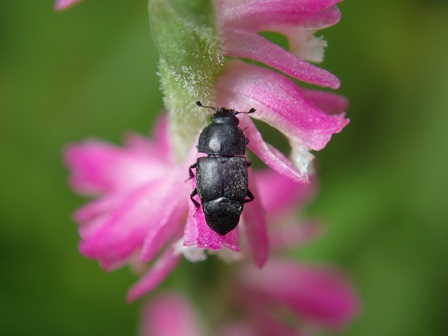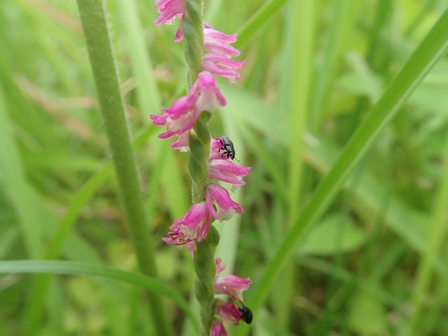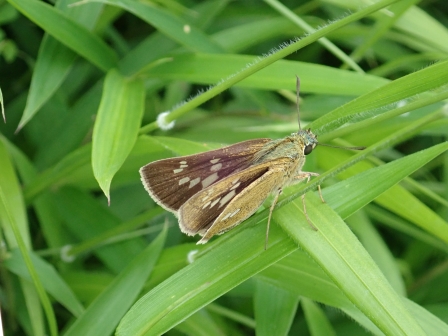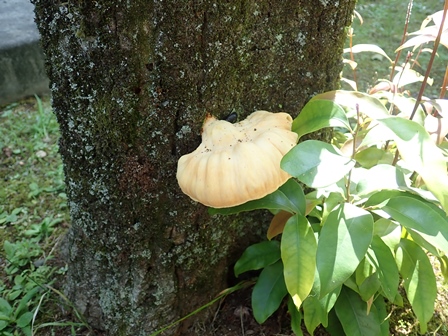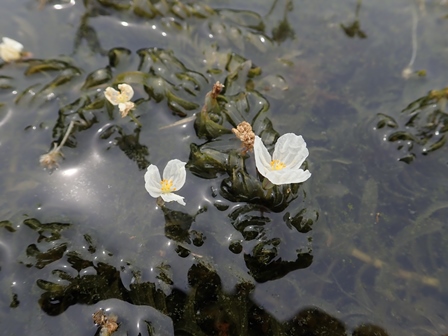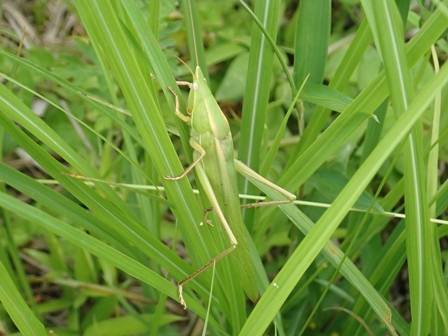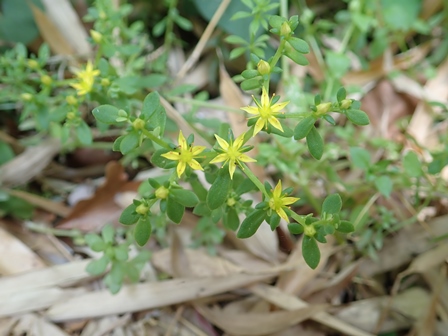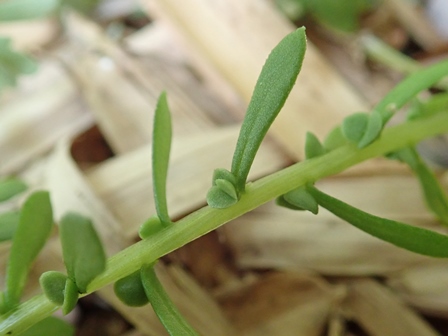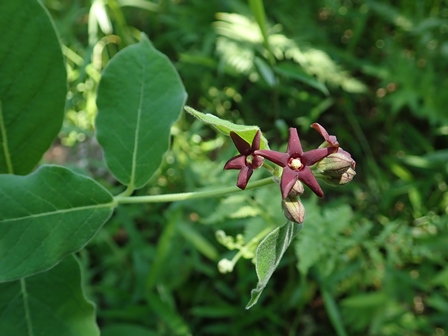フィールド日記
2020年06月
2020.06.30
クロハナケシキスイ
ススキ野原でクロハナケシキスイを見つけました。ケシキスイの仲間は触覚の先端が球状ふくらんでいるのが特徴です。本種は名前の通り、よく花に集まってきます。
このときは、2匹のクロハナケシキスイがらせん階段を上り下りするように、ネジバナの花穂上を移動していました。
I found "クロハナケシキスイ(kurohanakeshikisui)" in the Japanese pampas grass field. Beetles that belong to this group have antennae with rounded heads. "ハナ(hana)" in the name means "flower". As such, they often gather on flowers. This time, they came to the "ネジバナ(nejibana)" plant, and moved on the flowers like going up and down a spiral staircase.
2020.06.26
オオチャバネセセリ
第1オークヒルでオオチャバネセセリを見つけました。幼虫はササ類などを食草としており、草原や樹林周辺の草地に見られます。以前は普通に見られましたが、近年は数を減らしており、複数の県で絶滅危惧種に指定されています。不二聖心では不二農園の方々によって定期的に草刈りが行われているため、オオチャバネセセリの生育に適する環境が保たれていると考えられます。
I found this butterfly called "オオチャバネセセリ(oocyabaneseseri)" in the first Oak Hill. They are seen in grass fields and edges of woodlands because the larvae of them eat bamboo grasses. Before, they were common but now they have become endangered in several prefectures as their living places are decreasing. In Fuji Seishin, suitable places for this species to live are kept because farmers of the "不二農園(Fujinouen)" regularly cut grass.
2020.06.23
アイカワタケ
少し前から講堂横のスダジイの木に、クリーム色のモコモコしたキノコが生えています。手元の図鑑で調べると、アイカワタケのようです。シイ・カシ類に生じ、若いときは柔らかく、その後硬くなります。若いものであれば、火を通して食用になります。
The yellow fluffy mushroom has been growing on the "スダジイ(sudajii)" tree nearby the auditorium from several days. According to a reference book, it seems that it's called "アイカワタケ(aikawatake)". They grow on evergreen oak trees. Young ones are soft and then they become hard. When they are still young you can cook them and they become edible.
2020.06.19
オオカナダモ
池でオオカナダモの花が咲いています。理科の観察実験でおなじみの水草ですが、南米原産の帰化植物で各地に逸出・野生化して問題になっています。日本で野生化しているのは雄株のみで、種をつけることはありません。しかし、千切れた植物体から容易に増殖し、分布を広げています。不二聖心の池でも、意図的に入れたことはありませんが、いつの間にか侵入し、繁茂してしまっています。
2020.06.16
ツバメシジミ
ススキ野原でツバメシジミを見つけました。幼虫はシロツメクサやコマツナギなどのマメ科の植物を食草としています。翅の後ろの方に尾状突起と呼ばれる細く飛び出している部分があるのが特徴です。この尾状突起がツバメの尾羽を連想させることからツバメシジミと名付けられたと言われています。
I found this butterfly called "ツバメシジミ(tsubameshijimi)" in the Japanese pampas grass field. Its larva eats leguminous plants such as "シロツメグサ(shirotsumegusa)" plant and "コマツナギ(komatsunagi)" plant, etc. They have small slim projections, which are called "tail", on the rear of the wings. These tails have the imagine of the swallow birds tail feather. "ツバメ(tsubame)" means swallow birds. That's why this butterfly is called "ツバメシジミ(tsubameshijimi)".
2020.06.12
クビキリギス
ススキ野原でクビキリギスを見つけました。頭の先がとがっていることと、この写真では見えませんが、口が赤いことが特徴です。成虫で越冬し、春に繁殖するため、春の代表的な鳴く虫です。
I found "クビキリギス(kubikirigisu)" in the Japanese pampas grass field. They have two conspicuous features. One is the sharpened head and the other is a red mouth, which is invisible in this photo, though. They hibernate overwinter as adults and then breed in spring. So, they are representative of insects singing in Spring unlike other grasshoppers that sing in Autumn.
2020.06.09
ツボミオオバコ
オークヒルにツボミオオバコが見られます。全体に白い毛が目立つオオバコの仲間です。花弁が直立したまま開かないため、ずっと蕾のままのように見えることが名前の由来です。北アメリカ原産の帰化植物で、近年分布を広げているらしく、オークヒルでもたくさんの個体が見られます。
"ツボミオオバコ(tsubomioobako)" is in bloom now around the Oak Hill. It belongs to the "オオバコ(oobako)" plant group, which is one of the most common weeds in Japan. The plants body is dense with white hair. "ツボミ(tsubomi)" is written like this "蕾" in kanji and means "flower bud". The flower do not open and look like flower buds. That's why they are called "ツボミオオバコ(tsubomioobako)". They come from North America. These days, they are spreading around Japan and we can see them a lot around the Oak Hill as well.
2020.06.05
コモチマンネングサ
コモチマンネングサが咲いています。植え込みや道路のわきなどいたるところに生えています。和名のコモチは子持ちを意味し、葉の付け根にムカゴを作って仲間を殖やすことに由来しています。
コモチマンネングサのムカゴは下の写真に見られる丸い多肉質の葉状のものです。梅雨の時期に自然に地面に落ち、ほぼそのままの形で冬を越します。春に急速に成長をして花を咲かせます。通常は種子をつくらないため、ほとんどムカゴによって仲間を殖やしています。
"コモチマンネングサ(komochimannengusa)" is in bloom now. They live near shrubberies and by roadsides, etc. "コモチ(komochi)" is written like this "子持ち" in Kanji and it means "having children". That's because they have propagules on the base of leaves.
The small-succulent-leaf-like things, which you can see in the second picture, are propagules of "コモチマンネングサ". The propagules fall onto the ground in rainy season called "梅雨(tsuyu)", then stay as they are until spring time. In spring, they rapidly grow up and bloom. "コモチマンネングサ" usually does not bear fruits so they leave offsprings only by its propagules.
2020.06.02
フナバラソウ
クヌギ林の林縁でフナバラソウが咲いていました。明るい林縁や草地に見られます。近年生育地の減少などにより、全国的に絶滅が危惧されており、環境省のレッドリストでは絶滅危惧Ⅱ類に分類されています。不二聖心でも数株が見られるのみで、開花が確認できたのはこの1株だけでした。
"フナバラソウ(funabarasou)" is in bloom at the edge of the SawTooth oak woodland. In general, "フナバラソウ" lives at light edges of woodlands and in grasslands. However, these days, those places are decreasing due to urban development, etc. So "フナバラソウ" is classfied "Vulnerable" by the Ministry of Environment and so it considered endangered. There are a few "フナバラソウ" plants but only this one is in bloom in Fujiseishin.
- 1 / 1


